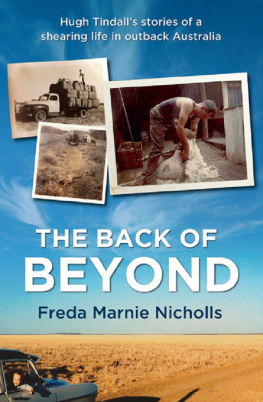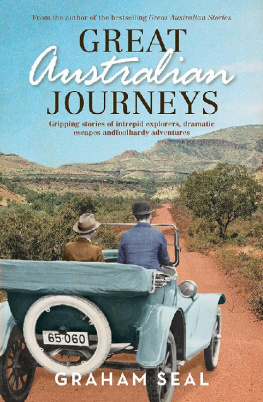TRUE STORIES
OF
EARLY AUSTRALIA
Copyright Richard G Tomkies
Smashwords Edition
Published by R.G. Tomkies November 2013
All rights reserved
No part of this book may be reproduced,stored in a retrieval system or transmitted by any means,electronic, mechanical, photocopying, recording or otherwise,without written permission from the author.

Richard G. Tomkies is a former journalistwhose passion is reading and writing books, particularly with anAustralasian theme. Although having lived in Canada where heimmigrated as a young man and with close ties to the United States,he now lives in tropical North Queensland, Australia, where hefinally immigrated with his wife and four children. To date he haspublished some seven books in print with a further three to follow,plus two new e-books. As for the latter, Death in TenSeconds has proved to be remarkably popular as an e-book. Akeen outdoorsman and hunter Richard has incorporated some of hisexperiences when deer-stalking in New Zealand, into his new novelDeath Stalks the Innocent.
Many and varied are the true stories ofyesteryear, ranging from castaways on the Queensland coast livingwith Aboriginal tribes to discoveries and investigations oflittle-known tribes of the Little People, the Barrineans forgotten rain-forest pygmies who inhabited the country from LakeBarrine, on Queenslands Atherton Tablelands, to the junglesbordering the coastal plains.
Events that occurred during Australiasearliest beginnings in the 19th Century are includedthrough to the middle of the 20th. Many months ofresearch has resulted in some fascinating stories with accompanyingphotographs providing added interest.
Life was hard during the days of earlysettlement, especially on some of Queenslands goldfields. Not onlydid the newcomers to the diggings have to deal with the vagaries ofthe tropical weather, but also with sickness, the lack of adequateprovisions and, at times, fierce attacks from the wild blacks who,incensed by the invasion of their land took out their revenge onthe hapless miners only to be dispersed in great numbers byruthless Native Police Troopers under the guidance of their whiteofficers.
Read about the courage of a lonely whitewoman, Lizzie Watson, the wife of a beche-de-mer fisherman leftalone in her hut on a desolate island off the coast from Cooktown,who, in a desperate attempt to flee marauding natives, escaped withher baby son in an iron water tank, only to perish from thirst.Among her possessions left behind in the tank was a diary whichtold of her last hours alone with her dying baby in the improvisedvessel.
This book graphically describes life amongpracticing cannibals in South Australia, as experienced by anEnglish woman, who, at the beginning of the 20thcentury, bravely attempted, with some success, in civilizing thenatives. Living a frugal existence with only a tent for shelter,she bravely managed to survive among some of Australias mostferocious and wild cannibals for sixteen years. Inspired by themany requests for more of the same by readers of a number of myarticles entitled In Days Gone By. These I wrote for a time forthe now defunct Northern Herald newspaper on the AthertonTablelands, Far North Queensland a few years ago.
Some of the stories herein include thosewritten in the above series and all are the research of manyhistorical papers and books and is a collection of true storiesfrom the late 19th Century to the middle of the20th Century. In so saying, I do not claim that any orall are historically correct, since over time many factual detailshave been lost or may have even been distorted to some degree.However, I have endeavored to the best of my ability to insure theaccuracy of those stories which have been related in variouspublications at the time or since, given the lapse of timeinvolved.
In researching a lot of the informationherein I am indebted to the writings and experiences of anEnglishman, the late Arthur Bicknell, who spent a number of yearsexploring parts of northern Queensland during the 1800s. I wouldalso like to acknowledge the late Hector Holthouse, an author ofrenown, some of whose research and work I have had reference to inthe course of writing this book, especially some of the seastories, as well as some news reports originally printed in anearly publication of a paper, The Auckland (NZ) SouthernCross in 1872. In researching material for this book I also hadaccess to the writings of Keith Windschuttle whom I would like tothank. He is the well-known editor of the Quadrant magazine,an established and well-known author and historian of some repute.In the chapter, Life Among the Cannibals in EarlyAustralia, I was fortunate to have recourse to the works ofthe late Daisy Bates who spent some thirty five years studying andliving with the Aborigines during the latter part of the19th Century through to the mid-1930s. My sincere thanksare also due to Bev Shay O.M. and her late husband John, of theCooktown Historical Society for use of material in their booksCannibalism or Murder in relation to the fate of theMacquarie brothers, two unfortunate men who were packers at thetime and whose bodies were never recovered. I am indebted to theShays for further material such as their little book BattleCamp Fact or Fiction? and last, but not least a copy oftheir book Forgotten Victims The Story of the StrauFamily all of which I have had recourse to, much of which hadbeen produced with the assistance of the Queensland State Archivesin their invaluable access to both documents and photographs.
I would like to take this opportunity toacknowledge and thank those whose unidentified photographs andillustrations which I have used. Where possible I have acknowledgedthe source of such works.
In researching the stories for this book Ihave come across, on occasion, various versions of the same storywith slightly differing accounts, which after the due lapse of timeinvolved made for some difficulty in ascertaining the correctversion. However, after due deliberation, I generally haveplumped for the version that either was the most probable or withcorroborating details from say, a newspaper article at the time.However, in a couple of cases, I have given both versionsfor the sake of readers interests! There are some events whichhave occurred during the 19th Century, for example TheNormanby Woman, (Chapter Thirty One) which, mainly through a lackof credible information have given arise to a number of myths whichhave entwined with fact.
Although a relatively young country, as faras white colonization is concerned, Australias early history ismarked with mayhem and violence extending from the coast to thevast hinterland, commonly known as the Outback. During the19th century Australias earliest beginnings were as apenal colony when convicted felons were sent to this country fromEngland although many were convicted of what today would bedescribed as a petty crime, such as the theft of a loaf ofbread to feed a starving family for example they were forced toserve out their time, or until pardoned, under a brutal regime.
The Queensland coast line is studded with thegraves of more than a thousand ships of various kinds, many ofwhich met their fate on the unforgiving coral outcrops of the GreatBarrier Reef which extends along the length of North Queensland.Both crews and passengers met their fate either by drowning orfalling into the hands of wild and often cannibalistic Aborigines,although a few survivors were luckier and were befriended by someless aggressive natives. Right from the days of early explorers,like Captain James Cooks












